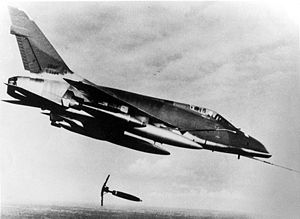
Home
FACs
More About FACs
The AO
A Shau Valley
• A Shau SF Camp
Hué
• Hué Cit Airfield
• MACV Compound
• LCU Ramp
• Hué Goose
Battle of Hué (Tet 1968)
• Trail FACs
The Missions
Visual Recon
• Sunken Sampan
Close Air Support
• CAS Munitions
• Rules of Engagement
• TACS
• Battle at Hua Cu
Interdiction
• McNamara Line
• Choke Points
Ranch Hand
Trail Dust Mission
Arc Light
SAR
Hammer 51 Rescue
Search for Jolly 23
• Msn Reports
• Search Area Map
• Search Rejoined
• Link to Past
Jungle Penetrator
Legacies
Aircraft
O-2A
Glossary
Resources
Contact
|

Close Air Support Munitions

|
Snake & Nape:
F-100 dropping Mk 82 Snakeye retarded bomb with BLU-1/B finned napalm canisters on the outboard pylons.
(USAF photo)
(Click image for larger view)
|
MK80-series of GP Bombs (comparison image)
Aerial Munition Minimum Safe Distances
|
Links to additional Close Air Support information:
|
Description of the Tactical Air Control System (TACS)
• TACS Areas of Responsibility (AOR)
Primer on Close Air Support Procedures
• CAS Guide for Ground Commanders
Primer on CAS munitions
Return to Top
| |